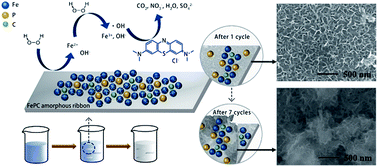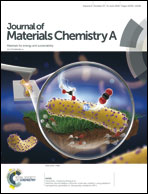Investigation of FePC amorphous alloys with self-renewing behaviour for highly efficient decolorization of methylene blue
Abstract
FePC amorphous ribbons using Fenton-like reactions are proved to show excellent degradation performance in wastewater treatment for the first time by decolorizing methylene blue (MB). Compared to the widely investigated FeSiB amorphous ribbons for decolorization, FePC alloys have higher degradation efficiency and lower reaction activation energy, which comes from the fast mass and electron transport due to the 3D nanoporous structures formed during the reaction, as well as the galvanic cells formed between the strong Fe–C and the weak Fe–P bonds. The observed unique “self-renewing” behaviour of FePC ribbons during cyclic tests explains their extremely long service life. The FePC amorphous ribbons are applicable in acidic MB solutions, but not in neutral or alkaline solutions. The highest degradation efficiency is achieved when the initial pH = 3 and the initial H2O2 concentration is 5 mM. The time required for the decomposition of MB drops with the increase of the ribbon dosage or the decrease of the initial MB concentration. This work not only provides a new highly efficient and low-cost solution for wastewater remediation, but also extends the application fields of FePC amorphous alloys.



 Please wait while we load your content...
Please wait while we load your content...